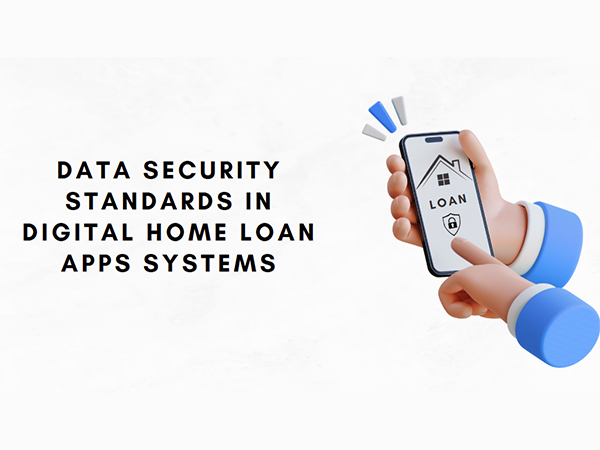Data Security Standards in Digital Home Loan Apps Systems
Feb 21, 2025
VMPL
New Delhi [India], February 21: Digital lending has made home loan apps easier and potentially more time-saving. Today, financial institutions and banks usually handle the critical personal and financial data of the applicant through a home loan app. However, this raises data privacy concerns among many applicants. To address this issue and ensure the security of such data, these apps use strong data protection measures. This article covers what data security measures are implemented by various home loan apps that lead to smooth loan processing.
Data Security Measures Used by Home Loan Apps
The following are some of the common and effective measures used by home loan apps to protect your important data.
Encryption Protection
The information on a home loan app is secured and kept confidential with strong encryption. Once users fill out the information on a home loan app, the system locks all the user's sensitive information and financial documents immediately. It's a digital safe with high-security clearance that doesn't allow unauthorised persons to have access to this information.
Access Management Systems
In a home loan app, data access is usually restricted with the help of multi-level verification systems. Only selected access is provided to home loan processing employees as per the defined roles in an organisation. It helps avoid unnecessary exposure of data by any unauthorised employee.
Secure Storage Protocols
Modern home loan apps store the data on protected servers under constant surveillance. The storage systems keep several copies of the data in different locations to safeguard against technical failures as well as security threats. Moreover, the security updates periodically maintain the effectiveness of these protective measures.
Data Collection Standards
Lending institutions follow strict guidelines about collecting only essential information for home loan processing. This approach reduces security risks by limiting the amount of sensitive data stored. Application forms on home loan apps clearly state why specific information is needed and how it will be used.
Biometric Authentication
Modern lending platforms incorporate fingerprint and facial recognition systems for user verification. These biological identifiers provide an additional security layer for home loan app users. The system stores biometric data in encrypted formats, separately on different servers from other important information.
Real-time Monitoring Systems
Financial institutions maintain continuous surveillance of their home loan app systems. Automated tools detect unusual patterns or suspicious activities in real time. This monitoring helps prevent unauthorised access and protects borrower information throughout the application process of taking home loans.
Document Verification Security
Digital lending platforms use advanced document authentication methods. These systems in a home loan app verify the authenticity of uploaded documents for home loan apps. Moreover, there are special encryptions available that many home loan apps use to protect sensitive documents during transmission and storage.
Consent Management
Consent management systems allow firms to manage, track, and record user consent if they collect sensitive data. Lending platforms are also using these systems nowadays. Hence, borrowers receive clear information about how their data will be used in the home loan process. The system maintains records of user permissions and allows borrowers to modify their consent settings.
Data Retention Policies
Financial institutions establish strict timeframes for storing information on their apps. These policies determine how long the home loan app keeps different types of borrower data. Regular data cleaning processes remove unnecessary information while preserving the required records.
User Access Rights
Borrowers receive tools to view and manage their stored information. The home loan app provides secure methods for users to access their loan application details. These features help maintain transparency in data handling practices. Furthermore, regular audits verify that lending platforms maintain proper data protection measures and update their systems as per the latest security standards.
Incident Response Planning
Lenders maintain detailed plans for addressing potential security issues. These procedures include steps for identifying problems, protecting customer data, and notifying affected borrowers. Such preparation helps ensure quick and effective responses to any security concerns. Clear communication protocols ensure all relevant staff members receive immediate notification of potential threats. Furthermore, professional security firms conduct periodic assessments to verify the effectiveness of response procedures.
System Recovery Protocols
Financial institutions implement complete recovery systems for their lending platforms. These protocols ensure smooth home loan processing even during security incidents. Backup systems maintain copies of important data in secure, separate locations. The recovery systems include automated tools for quick data restoration.
Conclusion
Modern lending institutions implement strong security frameworks while protecting customer data to make loan application processing safe as well as smooth. Financial institutions constantly update their security measures to overcome new challenges while simultaneously offering efficient lending services. Such security measures provide critical protection for borrower information while supporting simple digital lending processes. Furthermore, system upgrades regularly enhance security measures to perform at optimum levels. The combination of technology and human monitoring ensures reliable protection for digital lending services.
(ADVERTORIAL DISCLAIMER: The above press release has been provided by VMPL. ANI will not be responsible in any way for the content of the same)








